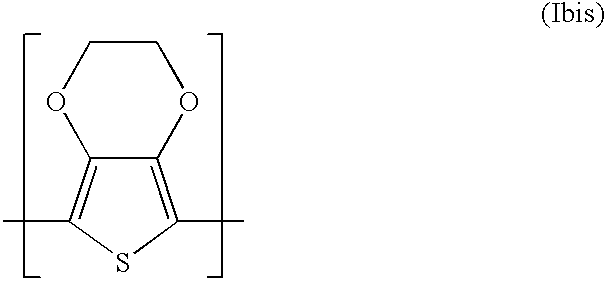Thin film inorganic light emitting diode
a light-emitting diode and thin film technology, applied in the direction of zinc sulfide, chemistry apparatus and processes, zinc sulfide, etc., can solve the problems of low fluorescent quantum yield, cumbersome and expensive vacuum-vapour deposition techniques, and low fluorescent quantum yield of tfel devices, so as to achieve easy and economical
- Summary
- Abstract
- Description
- Claims
- Application Information
AI Technical Summary
Benefits of technology
Problems solved by technology
Method used
Image
Examples
example 1
Preparation of a ZnS:Mn Dispersion
The following solutions were prepared:
To solution 3, stirred at 1500 rpm at 80.degree. C., solutions 1 and 2, both held at room temperature, were added simultaneously at a flow rate of 500 ml / min. This results in a predispersion comprising ZnS:Mn--particles.
To 1000 ml of this predispersion, 1000 ml of a 2% Na-polyphosphate solution in water was added and this dispersion was diafiltrated through a Fresenius F60 cartridge. The dispersion was concentrated to 1000 ml and washed at this level by using 6000 ml of a 2% solution of Na-polyphosphate in water.
After the washing, this dispersion was concentrated by means of a diafiltration set-up to a concentration of about 35 g ZnS / l. Subsequently, 1 ml of a 12.5% solution of Saponine Quillaya (Schmittmann) in water / ethanol (80 / 20) solution per 20 ml dispersion was added. This is the final ZnS:Mn dispersion.
The dispersion was analysed for its particle size distribution with the Disc Centrifuge Photosedimentome...
example 2
Preparation of a ZnS:Cu Dispersion
The following solutions were prepared:
To solution 6, stirred at 1500 rpm at 80.degree. C., solutions 4 and 5, both held at room temperature, were added simultaneously at a flow rate of 500 ml / min. This results in a predispersion comprising ZnS:Cu--particles.
To 1000 ml of this predispersion, 1000 ml of a 2% Na-polyphosphate solution in water was added and this dispersion was diafiltrated through a Fresenius F60 cartridge. The dispersion was concentrated to 1000 ml and washed at this level by using 6000 ml of a 2% solution of Na-polyphosphate in water.
After the washing, this dispersion was concentrated by means of a diafiltration set-up to a concentration of about 35 g ZnS / l. Subsequently, 1 ml of a 12.5% solution of Saponine Quillaya (Schmittmann) in water / ethanol (80 / 20) solution per 20 ml dispersion was added. This is the final ZnS:Cu dispersion.
The dispersion was analysed for its particle size distribution with the Disc Centrifuge Photosedimentome...
PUM
| Property | Measurement | Unit |
|---|---|---|
| thick | aaaaa | aaaaa |
| thick | aaaaa | aaaaa |
| thick | aaaaa | aaaaa |
Abstract
Description
Claims
Application Information
 Login to View More
Login to View More - R&D
- Intellectual Property
- Life Sciences
- Materials
- Tech Scout
- Unparalleled Data Quality
- Higher Quality Content
- 60% Fewer Hallucinations
Browse by: Latest US Patents, China's latest patents, Technical Efficacy Thesaurus, Application Domain, Technology Topic, Popular Technical Reports.
© 2025 PatSnap. All rights reserved.Legal|Privacy policy|Modern Slavery Act Transparency Statement|Sitemap|About US| Contact US: help@patsnap.com



